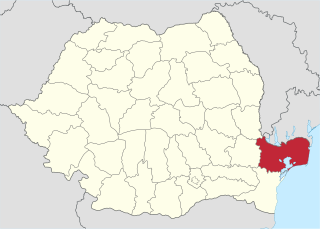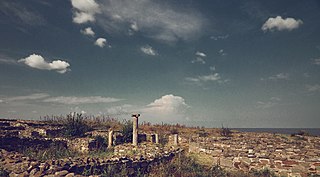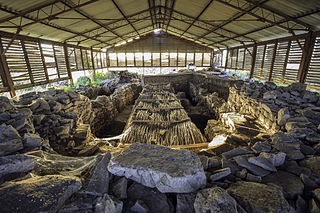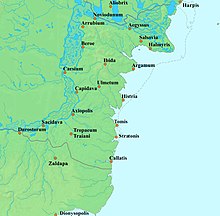
Moesia was an ancient region and later Roman province situated in the Balkans south of the Danube River. Moesian Province was first administered by governor of Noricum as 'Civitates of Moesia and Triballia'. It included most of the territory of modern eastern Serbia, Kosovo, north-eastern Albania, northern parts of North Macedonia, Northern Bulgaria, Romanian Dobruja and small parts of Southern Ukraine.

Northern Dobruja is the part of Dobruja within the borders of Romania. It lies between the lower Danube River and the Black Sea, bordered in the south by Southern Dobruja, which is a part of Bulgaria.

Dobruja or Dobrudja is a geographical and historical region in Southeastern Europe that has been divided since the 19th century between the territories of Bulgaria and Romania. It is situated between the lower Danube River and the Black Sea, and includes the Danube Delta, the Romanian coast, and the northernmost part of the Bulgarian coast. The territory of Dobruja is made up of Northern Dobruja, which is a part of Romania, and Southern Dobruja, which is a part of Bulgaria.

Constanța, historically known as Tomis or Tomi, is a port city in the Dobruja historical region of Romania. As the country's fourth largest city and principal port on the Black Sea coast, Constanța is the capital of Constanța County. It is also the oldest continuously inhabited city in the region, founded around 600 BC, and among the oldest in Europe.

Tulcea County is a county (județ) of Romania, in the historical region Dobruja, with the capital city at Tulcea. It includes in its northeast corner the large and thinly-populated estuary of the Danube.

Tulcea is a city in Northern Dobruja, Romania. It is the administrative center of Tulcea County, and had a population of 65,624 as of 2021. One village, Tudor Vladimirescu, is administered by the city. It is one of six Romanian county seats lying on the Danube river.

Mangalia, ancient Callatis, is a city and a port on the coast of the Black Sea in the south-east of Constanța County, Northern Dobruja, Romania.
The Archdiocese of Tomis is a diocese of the Romanian Orthodox Church within Constanța County. It is part of the Metropolis of Muntenia and Dobrudja. The seat is in Constanța. It is headed by Archbishop Teodosie Petrescu.

Troesmis was an ancient Dacian town and later ancient Roman city and legionary fortress, a major site situated on the Danube and forming a key part of the Limes Moesiae frontier system. Around the fortress the Geto-Dacian town developed.
Zyraxes was a Getae king who ruled the northern part of what is today Dobrogea in the 1st century BC. He was mentioned in relation with the campaigns of Marcus Licinius Crassus. His capital, Genucla, was besieged by the Romans in 28 BC, but he managed to escape and flee to his Scythian allies.

Trajan's Wall is the name used for several linear earthen fortifications (valla) found across Eastern Europe, Moldova, Romania, and Ukraine. Contrary to the name and popular belief, the ramparts were not built by Romans during Trajan's reign, but during other imperial periods. Furthermore, the association with the Roman Emperor may be a recent scholarly invention, only entering the imagination of the locals with the national awakening of the 19th century. Medieval Moldavian documents referred to the earthworks as Troian, likely in reference to a mythological hero in the Romanian and Slavic folklore. The other major earthen fortification in Romania, Brazda lui Novac, is also named after a mythological hero.

Histria or Istros was founded as a Greek colony or polis on the western coast of the Black Sea near the mouth of the Danube but whose banks are today about 70 km away. In antiquity, it also bore the names Istropolis, Istriopolis, and Histriopolis or simply Istros/Histros (Ἴστρος). It is near the modern town of Istria.

The Turks of Romania are ethnic Turks who form an ethnic minority in Romania. According to the 2011 census, there were 27,698 Turks living in the country, forming a minority of some 0.15% of the population. Of these, 81.1% were recorded in the Dobruja region of the country's southeast, near the Black Sea, in the counties of Constanța (21,014) and Tulcea (1,891), with a further 8.5% residing in the national capital Bucharest (2,388).

Halmyris was a Roman and Byzantine fort, settlement and naval port, located 2.5 km west of the village of Murighiol at the mouth of the Danube Delta in Romania. Its name in Roman times was probably Almyridensium.
This is a timeline of Romanian history, comprising important legal and territorial changes and political events in Romania and its predecessor states. To read about the background to these events, see History of Romania.

Libida or Ibida was an ancient city in Roman Moesia, later Roman Scythia Minor, today's Dobruja region of modern Romania. It is in the village of Slava Rusă.
This section of the timeline of Romanian history concerns events from Late Neolithic until Late Antiquity, which took place in or are directly related with the territory of modern Romania.
Argamum was a coastal fort in the ancient Roman province of Moesia. It was near the ancient Greek and Roman city of Argamum. It is located on Cape Dolosman in Romania. It covered two and a half hectares.
The Antiquity in Romania spans the period between the foundation of Greek colonies in present-day Dobruja and the withdrawal of the Romans from "Dacia Trajana" province. The earliest records of the history of the regions which now form Romania were made after the establishment of three Greek towns—Histria, Tomis, and Callatis—on the Black Sea coast in the 7th and 6th centuries BC. They developed into important centers of commerce and had a close relationship with the natives. The latter were first described by Herodotus, who made mention of the Getae of the Lower Danube region, the Agathyrsi of Transylvania and the Sygannae of Crişana.

The Battle of Histria, c. 62–61 B.C., was fought between the Bastarnae peoples of Scythia Minor and the Roman Consul Gaius Antonius Hybrida. The Bastarnae emerged victorious from the battle after successfully launching a surprise attack on the Roman troops; Hybrida escaped alongside his cavalry forces leaving behind the infantry to be massacred by the Bastarnian-Scythian attackers.






















